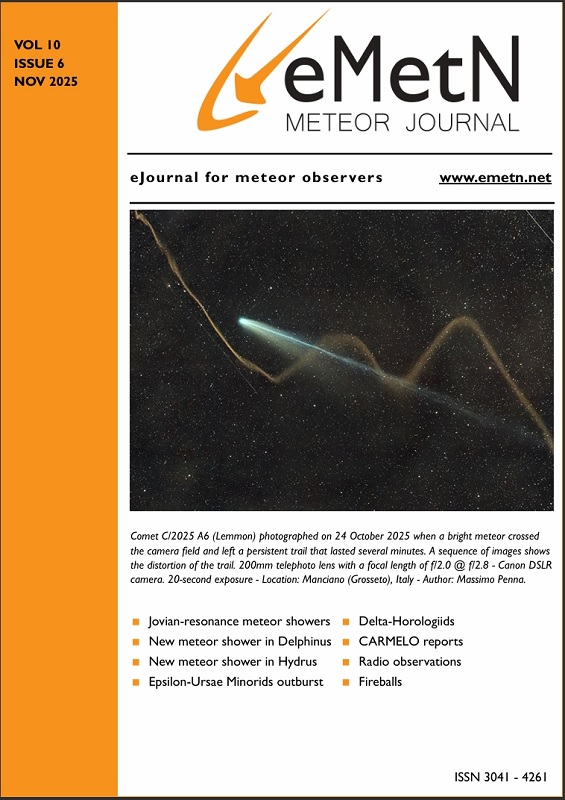Roberto Gorelli points our attention at a recently published meteor related paper.
Supercatastrophic disruption of asteroids in the context of SOHO comet, fireball and meteor observations
This paper has been submitted for publication to the Astronomical Journal by Paul Wiegert, Peter Brown, Petr Pokorny, Quanzhi Ye, Cole Gregg, Karina Lenartowicz, Zbigniew Krzeminski and David Clark
Abstract: Granvik et al. (2016) report an absence of asteroids on orbits with perihelia near the Sun that they attribute to the ’supercatastrophic disruption’ of these bodies. Here we investigate whether there is evidence for this process among other bodies with similarly low perihelia: near-Earth asteroids, SOHO comets, as well as meter-sized and millimeter-sized meteoroids. We determine no known near-Earth asteroids have past (last 104 years) histories residing significantly inside the Granvik et al. (2016) limit, indirectly supporting the disruption hypothesis. The exception is asteroid (467372) 2004 LG which spent 2500 years within this limit, and thus presents a challenge to that theory. Phaethon has a perihelion distance hovering just above the limit and may be undergoing slow disruption, which may be the source of its dust complex. We find that the rate at which ungrouped SOHO comets are observed is consistent with expected rates for the injection of small (25 m) class asteroids into the near-Sun region and suggest that this fraction of the SOHO-observed comet population may in fact be asteroidal in origin. We also find that there is an absence of meter-sized bodies with near-Sun perihelia but an excess of millimeter-sized meteoroids. This implies that if near-Sun asteroids disrupt, they do not simply fragment into meter-sized chunks but disintegrate ultimately into millimeter-sized particles.
We propose that the disruption of near-Sun asteroids as well as the anomalous brightening and destruction processes that affect SOHO comets occur through meteoroid erosion, that is, the removal of material through impacts by high-speed near-Sun meteoroids.
You can download this paper for free: https://arxiv.org/pdf/2001.09839.pdf (20 pages).
Older meteor library news:
2020
- Physical properties of Taurid meteoroids of various sizes, by Jiří Borovička and Pavel Spurný. (27 January 2020).
- The orbital clusters among the near Earth asteroids, by Tadeusz J. Jopek. (27 January 2020).
2019
- Parker Solar Probe Observations of a Dust Trail in the Orbit of (3200) Phaethon, by Karl Battams, Matthew M. Knight, Michael S.P. Kelley, Brendan M. Gallagher, Russell A. Howard, and Guillermo Stenborg. (22 December 2019).
- Meteoroid Stream Formation Due to the Extraction of Space Resources from Asteroids, by Logan Fladeland, Aaron C. Boley, and Michael Byers. (2 December 2019).
- Estimating trajectories of meteors: an observational Monte Carlo approach – II. Results, by Denis Vida, Peter G. Brown, Margaret Campbell-Brown, Paul Wiegert and Peter S. Gural. (27 November 2019).
- Estimating trajectories of meteors: an observational Monte Carlo approach – I. Theory, by Denis Vida, Peter S. Gural, Peter G. Brown, Margaret Campbell-Brown and Paul Wiegert. (11 November 2019).
- Meteor shower activity profiles and the use of orbital dissimilarity (D) criteria, by Althea V. Moorhead. (25 October 2019).
- A fireball and potentially hazardous binary near-Earth asteroid (164121) 2003 YT1, by Toshihiro Kasuga, Mikiya Sato, Masayoshi Ueda, Yasunori Fujiwara, Chie Tsuchiya, and Jun-ichi Watanabe. (18 October 2019).
- Spectral and orbital survey of medium-sized meteoroids, by Pavol Matlovic, Juraj Tóth, Regina Rudawska, Leonard Kornoš and Adriana Pisarcíková. (7 August 2019).
- Rising from Ashes or Dying Flash? Mega Outburst of Small Comet 289P/Blanpain in 2013, by Quanzhi Ye (叶泉志) and David L. Clark. (19 June 2019).
- Discovery of a Meteor of Interstellar Origin, by Amir Siraj and Abraham Loeb. (10 June 2019).
- A Mathematical Model for Simulating Meteor Showers, by M. Cardinot and A. Namen. (4 June 2019).
- The 2019 Taurid resonant swarm: prospects for ground detection of small NEOs, by David Clark, Paul Wiegert and Peter G. Brown. (28 May 2019).
- Analysis of the June 2, 2016 bolide event over Arizona, by Csaba Palotai, Ramanakumar Sankar, Dwayne L. Free, J. Andreas Howell, Elena Botella and Daniel Batcheldor. (25 May 2019).
- Identifying Interstellar Objects Trapped in the Solar System through Their Orbital Parameters, by Amir Siraj and Abraham Loeb. (5 May 2019).
- Meteor Shower Modeling: Past and Future Draconid Outbursts, by A. Egal, P. Wiegert, P. G. Brown, D. E. Moser, M. Campbell-Brown, A. Moorhead, S. Ehlert and N. Moticska. (1 May 2019).
- Meteoroid structure and fragmentation, by M. D. Campbell-Brown. (24 March 2019).
- Solar cycle variation in radar meteor rates, by M. D. Campbell-Brown. (26 February 2019).
- A New Meteoroid Model, by Valeri V. Dikarev, Eberhard Grün, William J. Baggaley, David P. Galligan, Markus Landgraf, Rüdiger Jehn. (12 February 2019).
- Lunar impacts, by Costantino Sigismondi. (12 February 2019).
- Lunar impact flashes, by C. Avdellidou and J. Vaubaillon. (10 February 2019).
- The Geminid parent body: (3200) Phaethon, by Patrick A. Taylor, Edgard G. Rivera-Valentín, Lance A.M. Benner, Sean E. Marshall, Anne K. Virkki, Flaviane C.F. Venditti, Luisa F. Zambrano-Marin, Sriram S. Bhiravarasu, Betzaida Aponte-Hernandez, Carolina Rodriguez Sanchez-Vahamonde and Jon D. Giorgini. (10 February 2019).
- Sun approaching asteroids and meteor streams, by Quanzhi Ye and Mikael Granvik. (10 February 2019).
2018
- Waiting to make an impact: A probable excess of near-Earth asteroids in 2018 LA-like orbits, by C. de la Fuente Marcos and R. de la Fuente Marcos. (18 December 2018).
- What mechanisms dominate the activity of Geminid Parent (3200) Phaethon?, by LiangLiang Yu, Wing-Huen Ip and Tilman Spohn. (6 November 2018).
- The Draconid meteoroid stream 2018: prospects for satellite impact detection, by Auriane Egal, Paul Wiegert, Peter G. Brown, Danielle E. Moser, Althea V. Moorhead and William J. Cooke (21 September 2018).
- Modeling the measurement accuracy of pre-atmosphere velocities of meteoroids, by Denis Vida, Peter G. Brown and Margaret Campbell-Brown (15 July 2018).
2017
- The Mayas and Eta Aquariids in AD 250-909, by J.H. Kinsman and D.J. Asher (31 July 2017).





